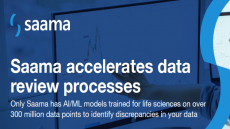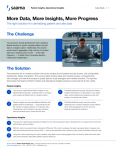Pharma leaders should step up on artificial intelligence: ConcertAI

The use of artificial intelligence (AI), real-world data (RWD), and other advanced tools have increased in recent years; regulatory bodies like the US Food and Drug Administration have weighed in with guidance documents and other resources.
As this technological evolution is happening, professionals in the drug development and research industry have the opportunity to step up and lead the way. Jeff Elton, CEO of ConcertAI, spoke with Outsourcing-Pharma and shared his views on how this shift in thinking might look, and the potential benefits of this new approach.
OSP: If you could, please share your perspective on the increased use of AI in drug discovery and development.
JE: I am going to separate drug discovery and development, as there are different data used and different intents at work here. In all cases, however, these are huge, paradigm-shifting, changes that will find some companies exiting, new ones forming, and the operating models of biopharma changing inexorably.
In drug discovery, though we have a set of published literature that informs our picture of genes responsible for resisting disease and the initiation of disease processes, we often find that there are missing data – meaning that we see processes at work but the genes and nodes in a biological pathway are incomplete. AI tools and solutions aid in accelerating insights, moving beyond what is in the current literature, to identify where there are likely targets or influential nodes previously undiscovered.
Further, biological pathways have what is often referenced as ‘redundancies’ built in. In other words, there is more than one way to keep ourselves alive and healthy. But diseases and mutant cells have these same built-in redundancies. So, when we design a new drug, we have to accommodate this so that our approach is not thwarted – and, equally as important, so that the drug doesn’t have “off-target” effects that we need to avoid for the patient’s safety. Here, too, AI is becoming more valuable as it can align the outcomes of primary interest – an effective therapy while aiding in avoiding the most negative of possible off-target effects for the majority of patients likely to receive treatment.
In clinical development, AI is becoming a new standard. In two to three years most major pharma, biopharma, and data science-centric CROs will be deploying AI and data science capabilities across the full scope of their enterprises.
We are seeing AI in guiding insights into where and how to deploy the initial early phase trials, even informing the clinical endpoints of interest and relevance. It is also underpinning the design of clinical studies, each parameter of the study, how those studies can assure representativeness and coverage of racial and ethnic sub-populations that may be disproportionally negatively impacted by the disease, and how to assure the statistical power of the study with a minimum of patient participants and sites activated.
OSP: As its use increases, how are leaders in the industry approaching ethics—what questions are being asked, and which are missed?
JE: AI technologies are just that ‘technologies’ that alone have no ‘intelligence.’ As such, effective AI needs training. This process requires knowledge of the data that is used to train the AI models, responsible sourcing of those data for assurance of representativeness, and lack of bias.
So, the assurance of ethical use starts at the point of consideration of using AI. It is then part of the model definition approach, model development, and model validation. Further, AI models are not ‘one and done’ – data are dynamic and outcomes are everchanging.
For example, non-small cell lung cancer patient outcomes prior to 2018, and certainly prior to 2015, would be useless to train models in that disease, as immuno-oncological therapies have transformed outcomes and greatly extended life in recent years. Similarly, we are seeing Next Generation Sequencing and ctDNA testing increase substantially across multiple diseases providing diagnostic information today that would have been reserved for only the largest and most well-funded academic centers five years ago.
Any company in this space needs well-defined approaches that stand in assurance of ethics and minimization of bias. This should include data that is representative of the disease, population parameter, or patient sub-population that is being modeled, and data from multiple electronic medical records, multiple diagnostic labs, multiple medical imaging systems. And all of this should be constantly evaluated - in fact, at ConcertAI, we’re now doing technical variability analyses to understand the bias that technologies and differences in the application of those technologies might bring to the data being generated, analyzed, and modeled.
OSP: How do you see the FDA's seal of approval (as it were) on the use of real-world data?
JE: This is a watershed moment. It indicates not just the possibility of using RWD to generate RWE on a selection of a study population, to establish the relevance of a clinical trial, and as a comparative population to which trial outcomes will be assessed. I was pleased to see AI appearing in a section on RWD and RWE for the first time – AI models will become part of processing and reading these data. It is early, but this will become a foundational technology to processing data for RWE studies.
This further creates a clear bridge between the formally distinct study universes of RWD retrospective studies and RCT prospective studies. We can now use RWE in assurance of the usefulness and appropriateness of the RCT design, complement the RCT study with aligned and roughly contemporaneously collected RWD, and use RWD as part of an external control arm for those programs getting breakthrough or other accelerated designation. This is critical for diseases that are the hardest to treat or currently non-responsive to existing therapies. I can see every sponsor in devasting or rare diseases bringing an RWE element into their consultative regulatory conversations and accompanying their submissions.
OSP: Could you please talk about how leaders in this area should challenge existing ideas about how research should be conducted and provide evidence for new approaches?
JE: I love this question. The question itself holds the answer. Leadership should be defined by challenging existing ideas. If you have new ways of generating evidence that are faster and may increase confidence in the decisions made, it is only responsible to bring these new approaches to bear.
This really means knowing the standard of care data deeply before designing a trial. What is not generally known is that ‘standard of care’ is not one thing. It varies by setting and sometimes as a result of access. Knowing this should inform where studies are run and how they are designed.
For example, 80% of Americans receive their cancer care in a community setting. These clinical practices and providers have a different reimbursement system and different access to diagnostic technologies than the top 10 academic oncology care centers. So, designing for the 80%, using RWD from the 80%, and running studies in the settings of the 80% should be a centering of all biopharma strategies.
OSP: How can research professionals in various corners ensure they're operating as ethically as possible?
JE: This takes a layered approach. Healthcare providers are actually serving their patients well if they allow responsible access to their data. The more data that is available, from broader settings, across more EMRs, etc., the better representative the data for the questions being asked.
The methodologies used need to be transparent and available for agency or peer review. For example, most studies use what is called ‘unstructured data’ – these are notes, PDFs, etc. To turn this into analyzable or machine-readable data they need to be ‘abstracted’ with sets of pre-defined rules.
These rules need to be considered part of the study design – for even subtly different rules applied to the same unstructured data and yield a different value. All AI models need to be published. All data need to have traceability, clear provenance, rely on ‘certified’ versions of the documents and data used.
Again, we are creating a new system. The creation of a system that is used, trusted, and influential on decisions requires a new set of ethics that is defined and built into our new working methods.
OSP: There is a lot of discussion about eliminating healthcare disparities and improving access in areas that include clinical research-how can industry professionals move beyond lip service and truly commit to making a difference?
JE: This is the core ethical dilemma of our time. It is now uncomfortably clear that we historically had a perverse combination of research on minority and ethnic groups without their consent and then also conducted billions of dollars of research that excluded large sub-populations of our country.
We are starting way behind on this one. When you are that far behind, small moves have no impact. The answer is to foreground health equity considerations in everything we do. We need to bring healthcare provider institutions into RWD analyses that never before participated.
We need to design all retrospective and prospective studies with a clear understanding of which racial, ethnic, and economic sub-populations are negatively or even disproportionately negatively impacted. You can see some of our approach to this in our December 2021 publication in the American Society of Hematology journal, Blood.
At ConcertAI, we are aligning with academic teams and regulators to make progress here. We are broadening our data network, building health equity considerations into every technology tool we make, and providing data, technology, and financial resources to academic researchers doing work in this area as a catalyst to progress,
OSP: Do you have any advice on how we can be guided by the need to bring innovative new drugs to the patients that need them-what does that mean?
JE: This likely means different things to different organizations. We created an internal initiative team, ERACE, dedicated to eliminating bias in biomedical research. We also formed an external academic and medical advisory board to review our work. We are doing joint research with the American Society of Clinical Oncology in health equity. This year we are including health equity considerations into every dataset, technology, proposal, or study – whether it is being asked for or not. It is our strong belief that most biases are non-conscious and unintentional as a result. As a result, elimination requires great and vigilant intentionality.
OSP: You’ve suggested that "pharma leaders need to throw out their playbooks in the face of data." Might there be a need for a new playbook, or industry standards around data/AI use and ethics?
JE: Absolutely. The new ‘playbook’ should have five core principles.
- The data you have, may not be the data you need. If you assume that legacy and unintentional bias underlay most data, one needs to understand this, redefine the questions of significance, and then be purposeful to build the data used to those new requirements.
- Trust and transparency are foundations to research and will underpin ad hoc analyses, formal study designs, and the data set used for a publication or submission.
- AI is only as good as the data that trained it, the intent of that training, and then the generalizability of where it was applied. Full transparency of foundation approaches can yield results that are meaningful, lacking in historical basis, and truly meaningful to the populations afflicted or questions of greatest import.
- Research is a collaborative endeavor, so having partners aligned to the approaches described in this conversation and vigilant to the goals of equity will be an additional assurance of that ethical orientation.
- Use the data, discuss the data, discuss the methods, bring RWE together with the RCT data, and do all of this during the registrational phase and over the entire life cycle of a therapeutic.
OSP: Do you have anything to add?
JE: These are among the most important questions of biomedical research, biomedical innovation processes, and standing in assurance that the broadest number of patients can benefit. Thank you for taking this focus.




















